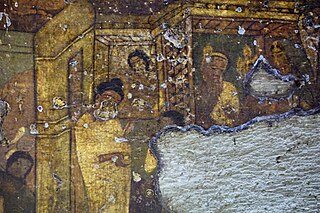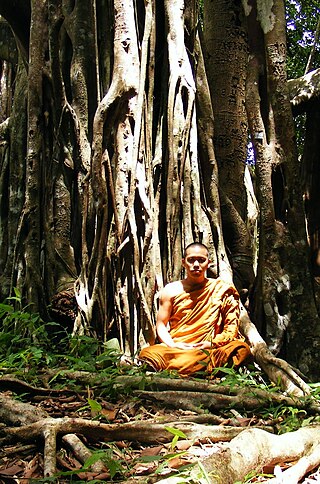Monasticism, also referred to as monachism, or monkhood, is a religious way of life in which one renounces worldly pursuits to devote oneself fully to spiritual work. Monastic life plays an important role in many Christian churches, especially in the Catholic, Orthodox and Anglican traditions as well as in other faiths such as Buddhism, Hinduism and Jainism. In other religions, monasticism is criticized and not practiced, as in Islam and Zoroastrianism, or plays a marginal role, as in modern Judaism. Many monastics live in abbeys, convents, monasteries or priories to separate themselves from the secular world, unless they are in mendicant or missionary orders.

Sangha is a Sanskrit word used in many Indian languages, including Pali which means "association", "assembly", "company" or "community"; In these languages, sangha is frequently used as a surname. In a political context, it was historically used to denote a governing assembly in a republic or a kingdom, and for a long time, it has been used by religious associations, including Buddhists, Jains and Sikhs. Given this history, some Buddhists have stated that the tradition of the sangha represents humanity's oldest surviving democratic institution.
Theravāda is the most commonly accepted name of Buddhism's oldest existing school. The school's adherents, termed Theravādins, have preserved their version of Gautama Buddha's teaching or Buddha Dhamma in the Pāli Canon for over two millennia.

A monastery is a building or complex of buildings comprising the domestic quarters and workplaces of monastics, monks or nuns, whether living in communities or alone (hermits). A monastery generally includes a place reserved for prayer which may be a chapel, church, or temple, and may also serve as an oratory, or in the case of communities anything from a single building housing only one senior and two or three junior monks or nuns, to vast complexes and estates housing tens or hundreds. A monastery complex typically comprises a number of buildings which include a church, dormitory, cloister, refectory, library, balneary and infirmary, and outlying granges. Depending on the location, the monastic order and the occupation of its inhabitants, the complex may also include a wide range of buildings that facilitate self-sufficiency and service to the community. These may include a hospice, a school, and a range of agricultural and manufacturing buildings such as a barn, a forge, or a brewery.
The Vinaya texts are texts of the Buddhist canon (Tripitaka) that also contain the rules and precepts for fully ordained monks and nuns of Buddhist Sanghas. The precepts were initially developed thirteen years after the Buddha's enlightenment. Three parallel Vinaya school traditions remain in use by modern ordained sanghas: the Theravada, Mulasarvastivada and Dharmaguptaka. In addition to these three Vinaya traditions, five other Vinaya schools of Indian Buddhism are preserved in Asian canonical manuscripts, including those of the Kāśyapīya, the Mahāsāṃghika, the Mahīśāsaka, the Sammatīya, and the Sarvāstivāda.

A monk is a person who practices religious asceticism by living a monastic lifestyle, either alone or with any number of other monks. A monk may be a person who decides to dedicate their life to serving other people and serving God, or to be an ascetic who voluntarily chooses to leave mainstream society and live their life in prayer and contemplation. The concept is ancient and can be seen in many religions and in philosophy.

A bhikkhu is an ordained male in Buddhist monasticism. Male and female monastics are members of the Sangha.
The Aṭṭhakavagga and the Pārāyanavagga are two small collections of suttas within the Pāli Canon of Theravada Buddhism. They are among the earliest existing Buddhist literature, and place considerable emphasis on the rejection of, or non-attachment to, all views.

Vassa is the three-month annual retreat observed by Theravada practitioners. Taking place during the wet season, Vassa lasts for three lunar months, usually from July to October.

Mahākāśyapa was one of the principal disciples of Gautama Buddha. He is regarded in Buddhism as an enlightened disciple, being foremost in ascetic practice. Mahākāśyapa assumed leadership of the monastic community following the paranirvāṇa (death) of the Buddha, presiding over the First Buddhist Council. He was considered to be the first patriarch in a number of Early Buddhist schools and continued to have an important role as patriarch in the Chan and Zen traditions. In Buddhist texts, he assumed many identities, that of a renunciant saint, a lawgiver, an anti-establishment figure, but also a "guarantor of future justice" in the time of Maitreya, the future Buddha—he has been described as "both the anchorite and the friend of mankind, even of the outcast".

Takuhatsu (托鉢) is a Japanese term used to refer to the Buddhist monastic almsround.

Tapas is a variety of austere spiritual meditation practices in Indian religions. In Jainism, it means asceticism ; in Buddhism, it denotes spiritual practices including meditation and self-discipline; and in the different traditions within Hinduism it means a spectrum of practices ranging from asceticism, inner cleansing to self-discipline by meditation practices. The Tapas practice often involves solitude and is a part of monastic practices that are believed to be a means to moksha.

Upasampadā (Pali) literally denotes "approaching or nearing the ascetic tradition." In more common parlance it specifically refers to the rite and ritual of ascetic vetting (ordination) by which a candidate, if deemed acceptable, enters the community as upasampadān (ordained) and is authorised to undertake ascetic life.

Buddhism, specifically Theravāda Buddhism, is the state religion of Myanmar since 1961, and practiced by nearly 90% of the population. It is the most religious Buddhist country in terms of the proportion of monks in the population and proportion of income spent on religion. Adherents are most likely found among the dominant Bamar people, Shan, Rakhine, Mon, Karen, and Chinese who are well integrated into Burmese society. Monks, collectively known as the sangha (community), are venerated members of Burmese society. Among many ethnic groups in Myanmar, including the Bamar and Shan, Theravada Buddhism is practiced in conjunction with the worship of nats, which are spirits who can intercede in worldly affairs.

Maechi or Mae chee are Buddhist monastics in Thailand who have dedicated their life to religion, vowing celibacy, living an ascetic life and taking the Eight or Ten Precepts. They occupy a position similar to sāmaṇerī.

Buddhist monasticism is one of the earliest surviving forms of organized monasticism and one of the fundamental institutions of Buddhism. Monks and nuns, called bhikkhu and bhikkhuni, are responsible for the preservation and dissemination of the Buddha's teaching and the guidance of Buddhist lay people. Three surviving traditions of monastic discipline (Vinaya), govern modern monastic life in different regional traditions: Theravada, Dharmaguptaka, and Mulasarvastivada.

Dhutanga or dhūtaguṇa (Sanskrit) is a group of austerities or ascetic practices taught in Buddhism. The Theravada tradition teaches a set of thirteen dhutangas, while Mahayana Buddhist sources teach a set of twelve dhūtaguṇas. The term is generally understood to be derived from the root dhu "to shake" and could mean practices which help one "shake off" the defilements. Thus, the dhutangas are meant help eliminate the defilements in the mind, and thus to deepen Buddhist practice. Their aim is to help the practitioner to develop detachment with material things including the body. Dhutanga practice is not considered a necessary requirement for a monk as is Śīla (virtue).
Bhiksha is a term used in Indic religions, such as Jainism, Buddhism and Hinduism, to refer to the act of alms or asking. Commonly, it is also used to refer to food obtained by asking for alms.

A bhikkhunī or bhikṣuṇī is a fully ordained female in Buddhist monasticism. Bhikkhunis live by the Vinaya, a set of either 311 Theravada, 348 Dharmaguptaka, or 364 Mulasarvastivada school rules. Until recently, the lineages of female monastics only remained in Mahayana Buddhism and thus were prevalent in countries such as China, Korea, Taiwan, and Vietnam, while a few women have taken the full monastic vows in the Theravada and Vajrayana schools. The official lineage of Tibetan Buddhist bhikkhunis recommenced on 23 June 2022 in Bhutan when 144 nuns were fully ordained.

The Kammatthana meditation tradition originally grew out of the Dhammayut reform movement, founded by Mongkut in the 1820s as an attempt to raise the bar for what was perceived as the "lax" Buddhist practice of the regional Buddhist traditions at the time. Mongkut's reforms were originally focused on scriptural study of the earliest extant Buddhist texts, revival of the dhutanga ascetic practices, and close adherence to the Buddhist Monastic Code. However, the Dhammayut began to have an increasing emphasis on meditation as the 19th century progressed. During this time, a newly ordained Mun Bhuridatto went to stay with Ajahn Sao Kantasīlo, who was then the abbot of a small meditation-oriented monastery on the outskirts of Ubon Ratchathani, a province in the predominantly Lao-speaking cultural region of Northeast Thailand known as Isan.

















